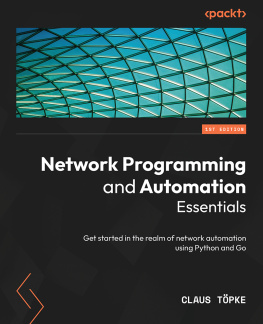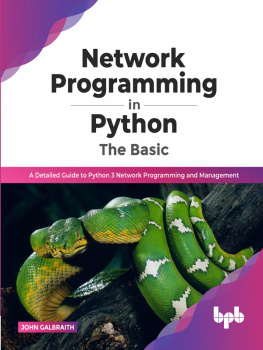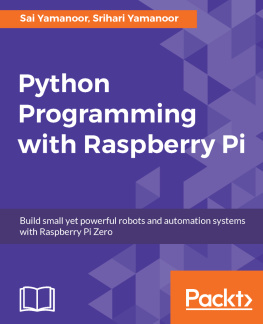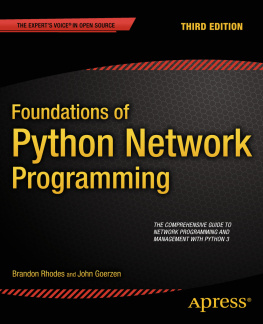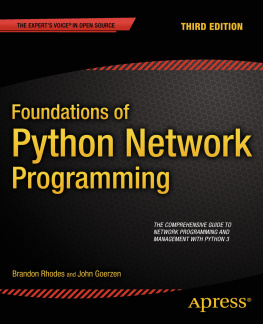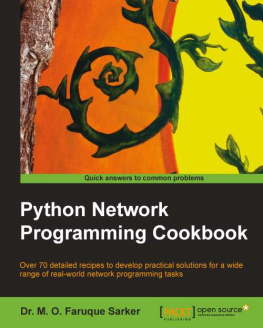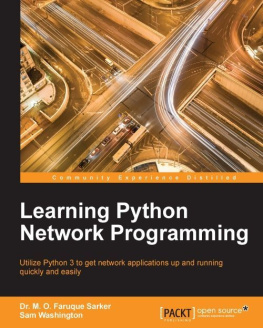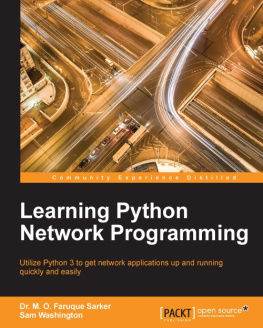Srivastava - Python Network Programming: Use Python 3.7 To Get Network Applications Up and Running Quickly and Easily
Here you can read online Srivastava - Python Network Programming: Use Python 3.7 To Get Network Applications Up and Running Quickly and Easily full text of the book (entire story) in english for free. Download pdf and epub, get meaning, cover and reviews about this ebook. year: 2020, publisher: UNKNOWN, genre: Home and family. Description of the work, (preface) as well as reviews are available. Best literature library LitArk.com created for fans of good reading and offers a wide selection of genres:
Romance novel
Science fiction
Adventure
Detective
Science
History
Home and family
Prose
Art
Politics
Computer
Non-fiction
Religion
Business
Children
Humor
Choose a favorite category and find really read worthwhile books. Enjoy immersion in the world of imagination, feel the emotions of the characters or learn something new for yourself, make an fascinating discovery.

- Book:Python Network Programming: Use Python 3.7 To Get Network Applications Up and Running Quickly and Easily
- Author:
- Publisher:UNKNOWN
- Genre:
- Year:2020
- Rating:3 / 5
- Favourites:Add to favourites
- Your mark:
- 60
- 1
- 2
- 3
- 4
- 5
Python Network Programming: Use Python 3.7 To Get Network Applications Up and Running Quickly and Easily: summary, description and annotation
We offer to read an annotation, description, summary or preface (depends on what the author of the book "Python Network Programming: Use Python 3.7 To Get Network Applications Up and Running Quickly and Easily" wrote himself). If you haven't found the necessary information about the book — write in the comments, we will try to find it.
Python Network Programming: Use Python 3.7 To Get Network Applications Up and Running Quickly and Easily — read online for free the complete book (whole text) full work
Below is the text of the book, divided by pages. System saving the place of the last page read, allows you to conveniently read the book "Python Network Programming: Use Python 3.7 To Get Network Applications Up and Running Quickly and Easily" online for free, without having to search again every time where you left off. Put a bookmark, and you can go to the page where you finished reading at any time.
Font size:
Interval:
Bookmark:
step by step
SACHIN Srivastava
Python Network Programming
Vendors such as Cisco, ALU, NSN, RedHat, and Canonical
Network elements such as MSC, VLR, HLR, MSCS, OCS, NGIN, and PCRF
Network protocol suites such as SS#7 and TCP/IP
Webpage technologies such as HTTP, XML, HTML, SOAP, and REST
Operating systems such as Linux (Debian, Ubuntu, RHEL, and CentOS), Windows, and Unix
Databases such as MongoDB, InfluxDB, MySQL, MS SQL, Oracle, and so on
Firewalls 24
Summary 28
Handling problems 33
Customizing requests 36
Content negotiation 40
Content types 40
Cookies 43
Cookie handling 44
Know your cookies 45
Redirects 47
URLs 48
Paths and relative URLs 49
Query strings 51
URL encoding 52
URLs in summary 54
HTTP methods 55
The HEAD method 55
The POST method 55
Formal inspection 56
HTTPS 58
The Requests library 59
Handling errors with Requests 63
Summary 64
Chapter 3: APIs in Action 65
Getting started with XML 66
The XML APIs 66
The basics of ElementTree 67
Element attributes 69
Converting to text 70
The Amazon S3 API 70
Registering with AWS 71
Authentication 71
Setting up an AWS user 72
S3 buckets and objects 74
An S3 command-line client 74
Creating a bucket with the API 76
Uploading a file 78
Retrieving an uploaded file through a web browser 79
Displaying an uploaded file in a web browser 80
Downloading a file with the API 81
Parsing XML and handling errors 82
Parsing XML 82
Finding elements 83
Handling errors 84
Further enhancements 84
The Boto package 85
Wrapping up with S3 87
JSON 87
Encoding and decoding 88
Using dicts with JSON 88
Other object types 89
The Twitter API 90
A Twitter world clock 91
Authentication for Twitter 91
Registering your application for the Twitter API 91
Authenticating requests 92
A Twitter client 92
Polling for Tweets 94
Processing the Tweets 95
Rate limits 96
Sending a reply 97
Final touches 98
Taking it further 99
Polling and the Twitter streaming APIs 99
Alternative oAuth flows 99
HTML and screen scraping 100
HTML parsers 101
Show me the data 102
Parsing HTML with lxml 102
Zeroing in 103
Searching with XPath 104
XPath conditions 105
Pulling it together 106
With great power... 107
Choosing a User Agent 108
The Robots.txt file 108
Summary 109
Chapter 4: Engaging with E-mails 111
E-mail terminologies 111
Sending e-mails with SMTP 112
Composing an e-mail message 113
Sending an e-mail message 114
Sending e-mails securely with TLS 117
Retrieving e-mails by using POP3 with poplib 121
Retrieving e-mails by using IMAP with imaplib 123
Sending e-mail attachments 126
Sending e-mails via the logging module 128
Summary 131
Chapter 5: Interacting with Remote Systems 133
Secure shell access using Python 134
Inspecting the SSH packets 137
Transferring files through SFTP 139
Transferring files with FTP 140
Inspecting FTP packets 142
Fetching Simple Network Management Protocol data 143
Inspecting SNMP packets 146
Reading Light-weight Directory Access Protocol data 147
Inspecting LDAP packets 151
Sharing files with SAMBA 153
Inspecting SAMBA packets 156
Summary 158
Chapter 6: IP and DNS 159
Retrieving the network configuration of a local machine 159
Manipulating IP addresses 161
IP network objects 162
Network interface objects 163
The IP address objects 164
Planning IP addresses for your local area network 165
GeoIP look-ups 167
DNS look-ups 168
Inspecting DNS client/server communication 170
NTP clients 172
Inspecting the NTP client/server communication 174
Summary 175
Basics of sockets 177
Working with TCP sockets 179
Inspecting the client/server communication 182
TCP servers 185
Inspecting client/server interaction 187
Working with UDP sockets 188
TCP port forwarding 190
A non-blocking socket I/O 193
Securing sockets with TLS/SSL 193
Inspecting standard SSL client/server communication 197
Creating a custom SSL client/server 201
Inspecting interaction between a custom SSL client/server 204
Summary 208
Chapter 8: Client and Server Applications 209
Client and server 210
An echo protocol 210
Framing 211
A simple echo server 213
Handling the received data 214
The server itself 215
A simple echo client 216
Concurrent I/O 218
Multithreading and multiprocessing 219
Threading and the GIL 220
A multithreaded echo server 222
Designing a chat server 223
A chat protocol 224
Handling data on persistent connections 225
Font size:
Interval:
Bookmark:
Similar books «Python Network Programming: Use Python 3.7 To Get Network Applications Up and Running Quickly and Easily»
Look at similar books to Python Network Programming: Use Python 3.7 To Get Network Applications Up and Running Quickly and Easily. We have selected literature similar in name and meaning in the hope of providing readers with more options to find new, interesting, not yet read works.
Discussion, reviews of the book Python Network Programming: Use Python 3.7 To Get Network Applications Up and Running Quickly and Easily and just readers' own opinions. Leave your comments, write what you think about the work, its meaning or the main characters. Specify what exactly you liked and what you didn't like, and why you think so.



